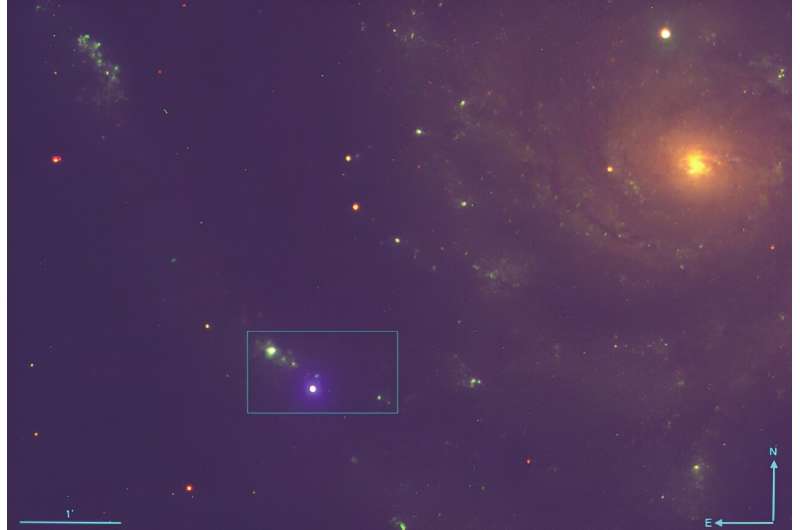This article has been reviewed according to Science X's editorial process and policies. Editors have highlighted the following attributes while ensuring the content's credibility:
fact-checked
peer-reviewed publication
trusted source
proofread
The most complete portrait of a supernova ever

Accounts of supernovae—exploding stars—go back thousands of years, and while we know today these events create the building blocks of life itself, there are still unanswered questions about the conditions that cause a star to explode.
Researchers from the Weizmann Institute of Science have now made major headway in better understanding these fascinating phenomena. Using multiple telescopes, including W. M. Keck Observatory on Maunakea, Hawaiʻi Island, they were able to gather data from a once-in-a-lifetime supernova called SN 2023ixf. Their findings are published in today's edition of the journal Nature.
Until recently, supernovae were considered rare with known occurrences in the Milky Way happening once a century at best, lighting up the night sky with the intensity of 100 million suns; the last observable explosion in our galaxy took place hundreds of years ago.
Advances in telescope technology have since helped identify supernovae in distant galaxies, supplying more data than was previously possible. Still, the same problem persists; since explosions can't be predicted, astrophysicists are like space archaeologists, usually arriving at the scene after the event and trying to piece together information from the remains.
"That's what makes this particular supernova different," says Ph.D. student Erez Zimmerman of Prof. Avishay Gal-Yam's group at Weizmann. "We were able—for the very first time—to closely follow a supernova while its light was emerging from the circumstellar material in which the exploding star was embedded."
The discovery was equivalent to getting to the scene of the crime while the crime was still taking place.
The scientists admit they were lucky. Gal-Yam's team applied for research time on NASA's Hubble Space Telescope, hoping to gather ultraviolet (UV) spectral data on any supernova interacting with its environment. Instead, they got the chance to witness in real-time one of the closest supernovae in decades: a red supergiant exploding in a neighboring galaxy called Messier 101, also known as the Pinwheel galaxy.
The team discovered SN 2023ixf on a Friday, the beginning of the weekend in Israel and right before the weekend in Baltimore's Space Telescope Science Institute—the operations center for the Hubble Telescope. Complicating things even further, it took place two days before Zimmerman's wedding. The team persevered and pulled an all-nighter on Friday, delivering the necessary measurements to NASA in the nick of time.
"It's very rare, as a scientist, that you have to act so swiftly," says Gal-Yam. "Most scientific projects don't happen in the middle of the night, but the opportunity arose, and we had no choice but to respond accordingly."
Not only did they succeed in getting Hubble to assume the right coordinates and angle for recording the necessary data, but because of the explosion's relative proximity, it turned out Hubble had already made recordings in this sector of the universe many times before. Turning to the NASA archives, Gal-Yam's team and many other groups were able to acquire data from before the star's eventual demise—when it was still just a red supergiant in its final stages of life—thus creating the most complete portrait of a supernova ever: a composite of its last days and death.
Observations of SN 2023ixf consisted of UV and X-ray data from NASA's Hubble and Swift satellites, as well as many of the best telescopes across the globe.
This included spectra captured using three of Keck Observatory's instruments—the Keck Cosmic Web Imager (KCWI), Deep Imaging and Multi-Object Spectrograph (DEIMOS), and Low Resolution Imaging Spectrometer (LRIS)—with each instrument offering a unique view of the supernova and how it changed over time.
The compilation of high-quality space- and ground-based data enabled the researchers to map out the two outer layers of the exploding star and come up with an extraordinary hypothesis.
"Calculations of the circumstellar material emitted in the explosion, as well as this material's density and mass before and after the supernova, create a discrepancy, which makes it very likely that the missing mass ended up in a black hole that was formed in the aftermath of the explosion—something that's usually very hard to determine," says Ph.D. student Ido Irani of Gal-Yam's team.
"Stars behave very erratically in their senior years," says Gal-Yam. "They become unstable and we usually cannot be sure which complex processes occur within them because we always start the forensic process after the fact, when much of the data has already been lost."
"This study presents a unique opportunity to better understand the mechanisms that lead to the conclusion of a star's life and the eventual formation of something entirely new," said Zimmerman.
Scientists may never find out what will happen to the matter that made up Messier 101's former red supergiant. However, the later stages of the supernova are ongoing and new data are still coming in, which means this study, along with follow-up studies of SN 2023ixf, could provide more insight into these explosive events.
More information: Erez Zimmerman, The complex circumstellar environment of supernova 2023ixf, Nature (2024). DOI: 10.1038/s41586-024-07116-6. www.nature.com/articles/s41586-024-07116-6
Journal information: Nature
Provided by W. M. Keck Observatory




















